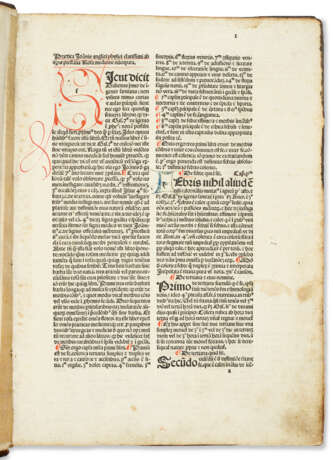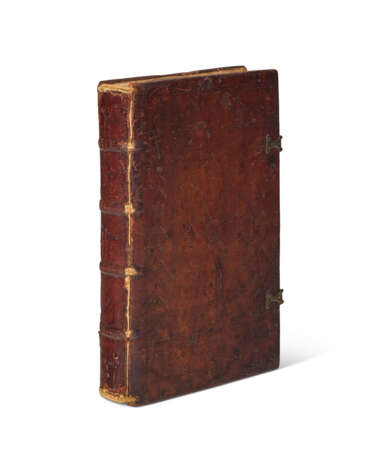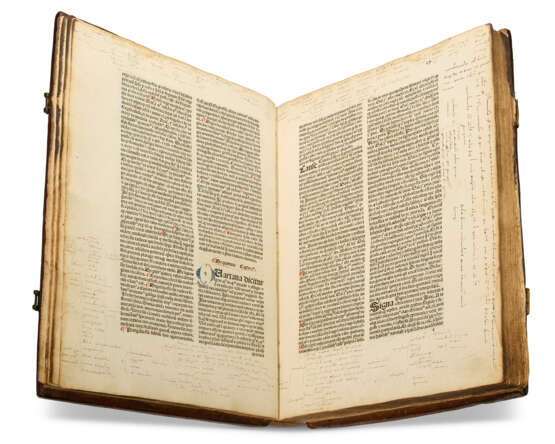ID 1360751
Lot 35 | Johannes de Gaddesden and Bernardus de Gordonio
Estimate value
$ 20 000 – 30 000
Gaddesden’s Rose and Gordon’s Lily – the Fourcroy copy. First edition of the first English medical textbook, with a first edition uroscopy. A physician to the royal family, ‘the first major medical scholar to have been trained wholly in England, and the only Oxford-trained medieval physician to achieve recognition on the continent’, John of Gaddesden wrote his magnum opus, Rosa anglica practica medicinae, while a Fellow of Merton College, Oxford between 1307 and 1316 (ODNB). Structured into five parts, resembling the petals of a rose and a symbol of royal authority, Gaddesden’s ‘detailed text is an exemplar of the mixture of received Hippocratic and Galenic lore compounded by medieval astronomy and religious injunction, which mixture was the essence of medieval medicine’ (Pearn). It cemented his reputation within his lifetime, and he saw his Rosa anglica as a democratizing solution for doctors who could not afford to maintain large medical libraries. In 1347/48, Edward the Black Prince gifted Gaddesden a rose crafted in gold for his service to the royal family and in recognition of this work.
The Rose is bound with a tract from Bernard de Gordonio’s Lilium medicinae, or Lily of Medicine, his seminal contribution to medieval medical knowledge. He was a professor at the University of Montpellier, where he established his reputation as a leading physician through his teaching and writings, such as this influential tract on uroscopy. Uroscopies as a genre dominated much medieval medical discourse, wherein metabolic waste was described in detail and shades of urine were connected to certain diagnoses – enshrining the urine test as an important prognostic tool as it remains today. Based on Galenic understandings of the humours and derived from Latin as well as earlier Greek and Arabic traditions, the medieval uroscopy continued into the early modern era.
Both Bernard and Gaddesden are cited by Chaucer when introducing the ‘Doctour of Phisick’ in the General Prologue to The Canterbury Tales. Chaucer lists various medical authorities to establish the vastness of the physician's learning, and concludes with ‘Bernard, and Gaddesden, and Gilbertyn’ – positioning them as contemporary medical authorities deemed worthy of appearing alongside authorities such as Hippocrates, Haly, Galen, Rhazes, Avicenna. J. Pearn, ‘Two Medieval Doctors: Gilbertus Anglicus (c.1180–c.1250) and John of Gaddesden (1280–1361)’, Journal of Medical Biography 21.1 (2013), 3–7. The Dome of Uryne, ed. M.T. Tavormina (Oxford: Early English Text Society, 2019). I: HC *1108; BMC VII 1005; BSB-Ink I-394; Bod-inc J-158; CIBN J-219; GW M13622; Goff J-326; Klebs 424.1; ISTC ij00326000. II: HR 7804 = 7803 (I); BMC VI 604; CIBN B-320; GW 4087; Goff B-454; Klebs 180.1; ISTC ib00454000.
Two works bound together, chancery folio (291 × 214mm). 178 leaves, including final blank (first work); 24 leaves (second work). Initials in alternating red and blue over printed guide-letters, paragraph marks in red (title-page with some soiling and author and imprint details neatly written in manuscript, blue paint sometimes rubbed, first and last quires re-hinged and finger-soiled, ink stain at fore-edge visible on first and last few quires, scattered few spots and a few leaves toned or with marginal spotting, 2b2 with long repaired tear at gutter margin). Contemporary blindstamped calf (old rebacking and later endpapers, corners repaired, hinges showing, clasps lacking, a little worming to lower cover); custom clamshell box. Provenance: contemporary Latin marginalia throughout both volumes (most substantial in the first 30 pages) – few additional instances early marginalia – illegible ownership inscription on title – Antoine-François du Fourcroy (1755–1809; his sale, Tilliard, Paris, 10 December 1810, lot 1213; possibly his bibliographic inscription on flyleaf). 19th-century French bibliophilic notes on front free endpaper – Kenneth Rappoport (bookplate).
| Place of origin: | Italy |
|---|---|
| Auction house category: | Antiquarian books, Medicine & science, Printed books |
| Place of origin: | Italy |
|---|---|
| Auction house category: | Antiquarian books, Medicine & science, Printed books |
| Address of auction |
CHRISTIE'S 20 Rockefeller Plaza 10020 New York USA | ||||||||||||||
|---|---|---|---|---|---|---|---|---|---|---|---|---|---|---|---|
| Preview |
| ||||||||||||||
| Phone | +1 212 636 2000 | ||||||||||||||
| Fax | +1 212 636 4930 | ||||||||||||||
| Conditions of purchase | Conditions of purchase | ||||||||||||||
| Shipping |
Postal service Courier service pickup by yourself | ||||||||||||||
| Payment methods |
Wire Transfer | ||||||||||||||
| Business hours | Business hours
|





